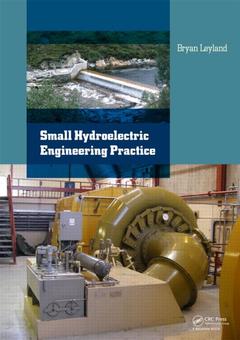Description
Small Hydroelectric Engineering Practice
Author: Leyland Bryan
Language: English
Subjects for Small Hydroelectric Engineering Practice:
Keywords
Francis Turbines; draft; Draft Tube; tube; Pelton Turbines; francis; Small Hydropower Schemes; turbine; Runaway Speed; kaplan; Spiral Casing; spiral; Guide Vane; casing; Kaplan Turbines; guide; Earthing Systems; vanes; Waterfall; pelton; Steel Penstocks; Turgo Turbine; Radial Gates; Bulb Turbine; Relief Valve; Inlet Valve; Low Head Turbines; Turbine Runner; Turbine Cover; Water Hammer Pressures; Jet Deflector; Generator Terminals; NPV; Head Loss; Cost Estimate
· 17.4x24.6 cm · Paperback
Description
/li>Contents
/li>Readership
/li>Biography
/li>
Small Hydroelectric Engineering Practice is a comprehensive reference book covering all aspects of identifying, building, and operating hydroelectric schemes between 500 kW and 50 MW. In this range of outputs there are many options for all aspects of the scheme and it is very important that the best options are chosen.
As small hydroelectric schemes are usually built against a limited budget it is extremely important that the concept design is optimum and every component is designed to maximise the benefi t and minimise the cost. As operating costs are often a high proportion of the income it is very important to make sure that everything is designed to be simple, reliable and long lasting.
The book is based on the experience gained over 45 years on the overall and detailed design, construction and commissioning of more than 30 small hydropower schemes. It includes contributions from experts in the field of intakes, water diversion structures, geology, canals, painting and other aspects of hydropower development. It is intensely practical with many drawings and photographs of schemes designed and commissioned by Leyland Consultants and others. There are also sections on preparing specifi cations, tender assessment and operation and maintenance.
The book includes a CD with spreadsheet programs for analysing aspects of small hydropower development and many arrangement drawings and detail designs for gates, penstocks, electrical systems and control systems. Typical specifi cations for generating plant are also included. The spreadsheets will be useful during the feasibility stage and the drawings will enable designers to scale the designs as needed for their own projects. Consultants, developers, designers, builders and operators of small hydroelectric schemes will find this book invaluable..
1. Introduction 2. Scheme identification 3. Refining the design 4. Detailed design of intake works, canals and penstocks 5. Turbine selection 6. Generators 7. Electrical systems 8. Auxiliary plant 9. Specifications and contracts 10. Powerhouse layout and design 11. Construction and commissioning 12. Operation 13. Lessons from failures
Appendices: 1. Useful spreadsheets and computer programs 2. Financial and economic considerations 3. Environmental issues with two hydropower schemes 4. Making the most of hydro specifications
Bryan Leyland trained in New Zealand and then went overseas for nine years. During this time he worked on power projects all over the world. He returned to New Zealand in 1970 to work for Lloyd Mandeno, an outstanding hydropower engineer. In 1974 Bryan set up his own consulting firm and spent most of the next 25 years working on the overall and detailed design and commissioning of 26 small hydropower schemes totaling 250 MW and the refurbishment of 27 schemes in New Zealand and overseas. Ten of the scheme won awards as "engineering projects of outstanding technical significance". On three occasions he was involved in the repair and recommissioning of schemes that had suffered catastrophic failures. This gave him a valuable insight into the need for high quality geotechnical and civil engineering. He has also acted as a consultant to the World Bank and to the Asian Development Bank on hydropower investigations and on dam safety. He has written many papers on hydropower development, power systems and electricity markets. In 2009 he was listed by Waterpower and Dam Construction as one the 60 most influential people in the hydropower industry worldwide.
These books may interest you

Spillway Design - Step by Step 172.36 €



